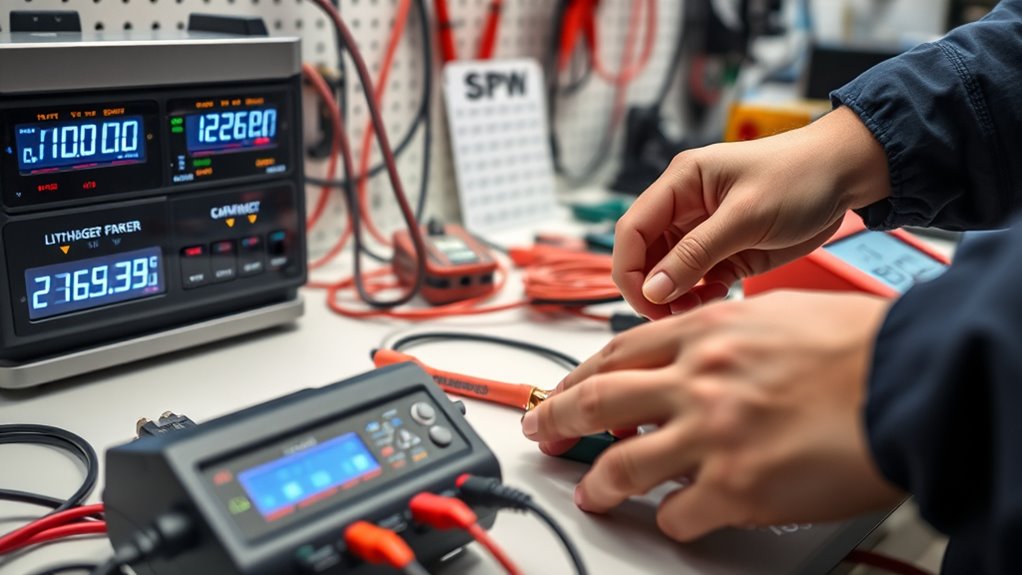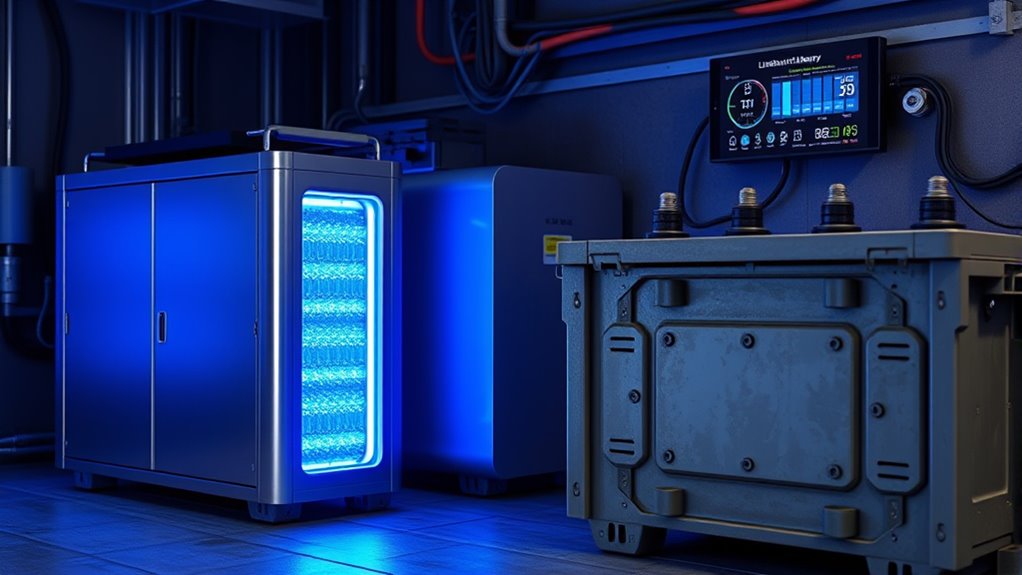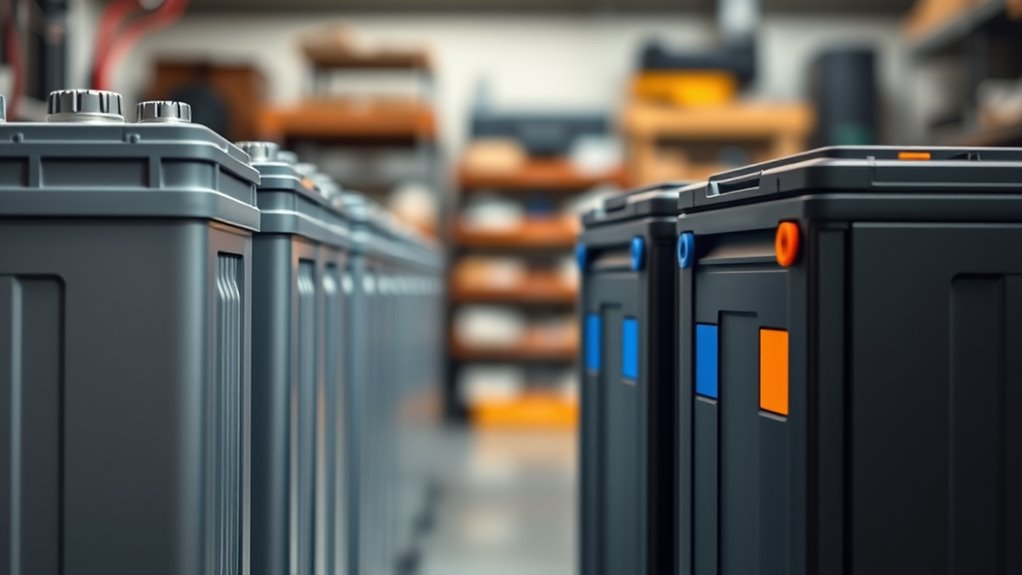Switching from lead-acid to lithium batteries means you’ll need to adjust your wiring to handle higher currents safely, often upgrading wire gauges and ensuring proper fusing. You’ll also have to update your charging system with a lithium-compatible charger and proper settings to avoid damaging the new batteries. Safety measures like venting and monitoring are vital, and you’ll need to manage battery health with a good BMS. For a seamless, safe shift, consider all these changes in your system.
Key Takeaways
- Upgrade wiring and wire gauges to support lithium’s higher current peaks safely.
- Use a lithium-compatible charger with proper charging profiles to prevent cell damage.
- Implement safety measures like ventilation, thermal cutoffs, and regular inspections for fire risk reduction.
- Install a Battery Management System (BMS) to monitor voltage, current, and temperature in real-time.
- Verify system component compatibility and update connectors to handle lithium’s higher energy density.
Adjustments in Battery Wiring and Configuration

Have you considered how switching from lead-acid to lithium batteries impacts your wiring setup? You’ll need to make circuit modifications to guarantee your system handles lithium’s different characteristics. Lithium batteries can deliver higher current peaks, so wiring adjustments are essential to prevent overheating and voltage drops. You might need to upgrade wire gauge sizes to support increased current flow safely. Additionally, check your fuse ratings and circuit breakers, as they should match the new battery’s specifications. Proper wiring ensures peak performance and safety, avoiding potential damage or fire hazards. Moreover, understanding the current handling capacity of your wiring is crucial when transitioning to lithium batteries, as it directly affects system performance and longevity. Considering the battery chemistry and its impact on wiring requirements is also important for a safe upgrade. Remember, each battery type has unique wiring requirements, so don’t overlook these critical modifications when transitioning to lithium. Making these adjustments now will help your system operate smoothly and efficiently, especially when considering system safety and reliability.
Upgrading Charging Equipment and Settings

Since lithium batteries have different charging requirements than lead-acid ones, upgrading your charging equipment is essential. Lithium’s battery chemistry demands specific charging protocols to ensure safety and longevity. You’ll need a charger compatible with lithium batteries, capable of adjusting voltage and current according to the manufacturer’s specifications. This often means switching to a charger with lithium-specific charging profiles that respect the proper bulk, absorption, and float stages. Using equipment designed for lead-acid batteries can lead to overcharging or undercharging, damaging the lithium cells. Make sure your charger’s settings are configured to match your new battery chemistry. Properly upgrading your charging equipment guarantees efficient charging, maximizes battery life, and maintains system safety during operation. For optimal performance, consider portable power options that are tailored to lithium systems and your specific use-case. Additionally, understanding the battery management system is crucial for maintaining overall system health and safety. Incorporating proper system integration ensures your upgrade functions seamlessly within your existing setup. Regularly consulting manufacturer guidelines helps ensure your system remains safe and effective over time. It’s also important to stay informed about system monitoring to promptly identify any issues and optimize performance.
Implementing Safety Measures and Precautions

Upgrading your charging equipment to suit lithium batteries substantially improves performance, but it also introduces new safety considerations. You must prioritize fire safety by ensuring proper ventilation and avoiding overcharging or thermal runaway. Adequate venting is essential, as lithium batteries can emit gases if damaged or overheated. Install venting requirements that direct any gases safely away from living spaces and electrical components. Regularly inspect batteries for signs of damage, swelling, or leaks, and keep fire extinguishers nearby rated for electrical fires. Implement safety measures such as thermal cutoffs and alarms to alert you of abnormal temperatures. Recognizing the importance of fathers’ guidance can help foster a careful approach to safety practices. Additionally, understanding environmental considerations helps in minimizing ecological impact and maintaining sustainable practices. Proper battery maintenance and adherence to safety protocols are crucial in preventing potential hazards. Incorporating lithium-specific safety features can further reduce risks associated with these batteries. Staying informed about cybersecurity threats related to battery management systems and charging networks is also vital to prevent unauthorized access and ensure system integrity. Taking these precautions minimizes risks, prevents fires, and guarantees a safer, more reliable system when shifting from lead-acid to lithium batteries.
Monitoring and Managing Battery Health

Regularly monitoring your lithium batteries is essential to maintain peak performance and safety. Keep a close eye on the state of charge to prevent over-discharge or overcharging, which can damage the battery and reduce lifespan. Use a reliable battery management system (BMS) to track voltage, current, and temperature in real-time. Thermal management is critical; guarantee your batteries stay within ideal temperature ranges to avoid overheating or freezing. Proper ventilation and cooling systems help regulate heat, preventing thermal runaway and prolonging battery health. Regular checks and adjustments allow you to catch issues early, maximizing battery efficiency and safety. Understanding running dry can help you recognize signs of depletion before they impact your system’s performance. By actively managing the state of charge and thermal conditions, you assure your lithium batteries operate reliably and last longer. Additionally, understanding battery health management can further optimize system longevity and safety, especially through industry trends that introduce new monitoring technologies. Ensuring that your system incorporates advanced diagnostic tools can also enhance proactive maintenance and troubleshooting efforts.
Integrating Lithium Batteries With Existing Systems

Integrating lithium batteries into your existing systems requires careful planning to guarantee compatibility and peak performance. Since battery chemistry varies, you’ll need to verify your system components can handle lithium’s unique characteristics. Compatibility issues can lead to reduced lifespan or safety concerns if not addressed properly. To facilitate a seamless transition, consider these key points:
Ensure system compatibility and update components for safe, optimal lithium battery integration.
- Verify system compatibility with lithium battery chemistry, including voltage and current requirements.
- Update or replace chargers and BMS (Battery Management Systems) designed specifically for lead-acid batteries.
- Assess wiring and connectors to support the higher energy density and different discharge profiles of lithium batteries.
Frequently Asked Questions
How Long Does It Take to Fully Switch From Lead-Acid to Lithium?
Switching from lead-acid to lithium batteries usually takes around 1 to 2 weeks, depending on your system’s complexity. Did you know lithium batteries offer up to 70% more usable capacity? The installation timeline involves ordering the batteries, preparing your system, and performing the swap. You can streamline this process by working with professionals, ensuring a smooth progression without much downtime, so you’re ready to enjoy the benefits quickly.
Are There Any Legal or Regulatory Considerations for Lithium Batteries?
You need to be aware of battery regulations and safety standards when switching to lithium batteries. Check local, state, and federal laws, as some areas have restrictions or specific requirements for lithium battery usage and disposal. Confirm your batteries meet safety standards like UN38.3 for transport and UL certifications for safety. Staying compliant prevents legal issues and guarantees safe operation of your lithium system.
Will My Existing Solar System Work With Lithium Batteries?
Your existing solar system can often work with lithium batteries, but you need to check battery compatibility and system integration. Lithium batteries have different charging requirements and voltage profiles than lead-acid ones, so make certain your inverter and charge controller support lithium chemistry. Verify with your equipment manufacturer or a professional installer to confirm compatibility, preventing potential issues and maximizing your system’s efficiency and longevity.
What Is the Typical Lifespan Difference Between Lead-Acid and Lithium?
You’ll find that lithium batteries typically last 10 to 15 years, while lead-acid ones usually last 3 to 5 years. With lithium, you’ll need less frequent battery maintenance and should follow safety precautions, like avoiding overcharging. Proper care extends lifespan, so keep an eye on voltage levels and temperature. Lithium batteries are more durable, making them a smart investment if you prioritize longevity and safety.
Can I Upgrade My System Gradually or Is a Complete Overhaul Necessary?
You can upgrade your system gradually; over 60% of users do so to manage costs. Just make certain your batteries are compatible with your existing system and check the installation process for each upgrade step. This approach allows you to shift seamlessly without a complete overhaul. Take your time, verify compatibility, and follow proper installation procedures to guarantee safety and ideal performance during your upgrade.
Conclusion
Switching from lead-acid to lithium might seem like a simple upgrade, but don’t be fooled—your system will demand more attention than ever. Ironically, while lithium batteries promise longer life and better performance, they require careful wiring, precise charging, and vigilant monitoring. It’s almost like going from a slow, predictable ride to a high-speed adventure—exhilarating but definitely not for the faint of heart. Ready to embrace the chaos? Your system’s transformation awaits.









